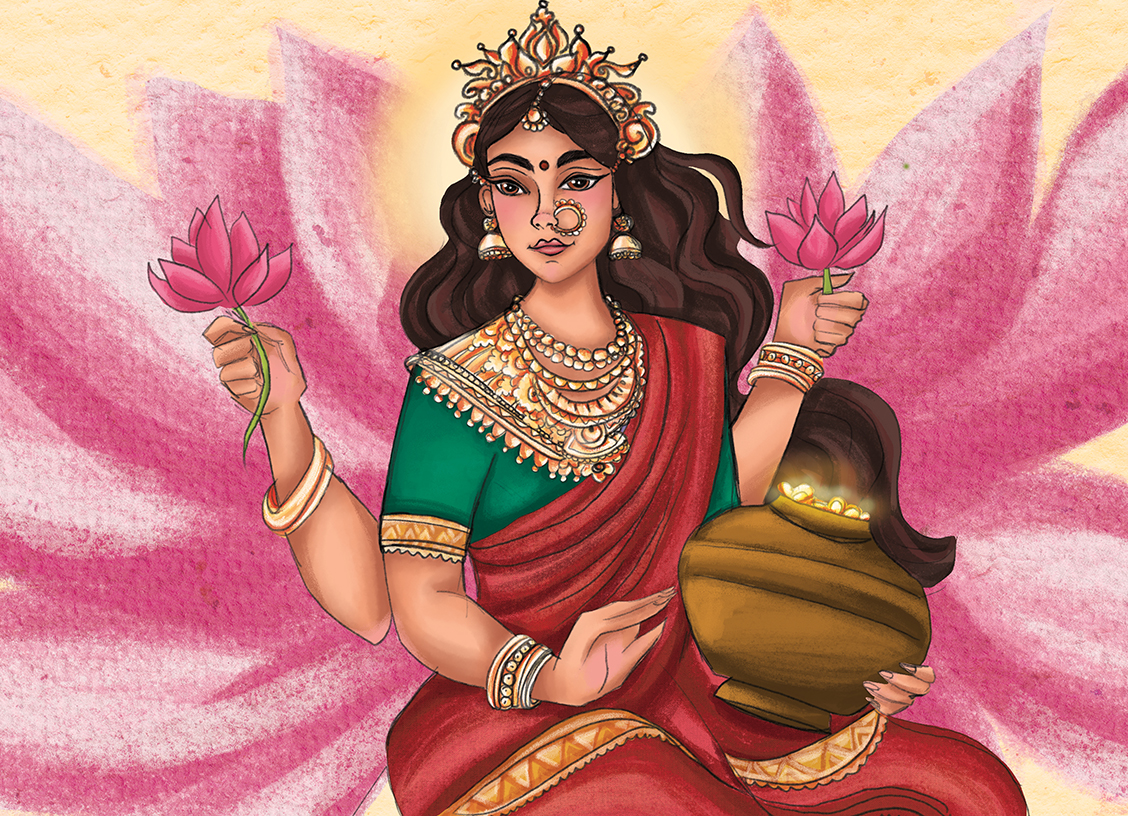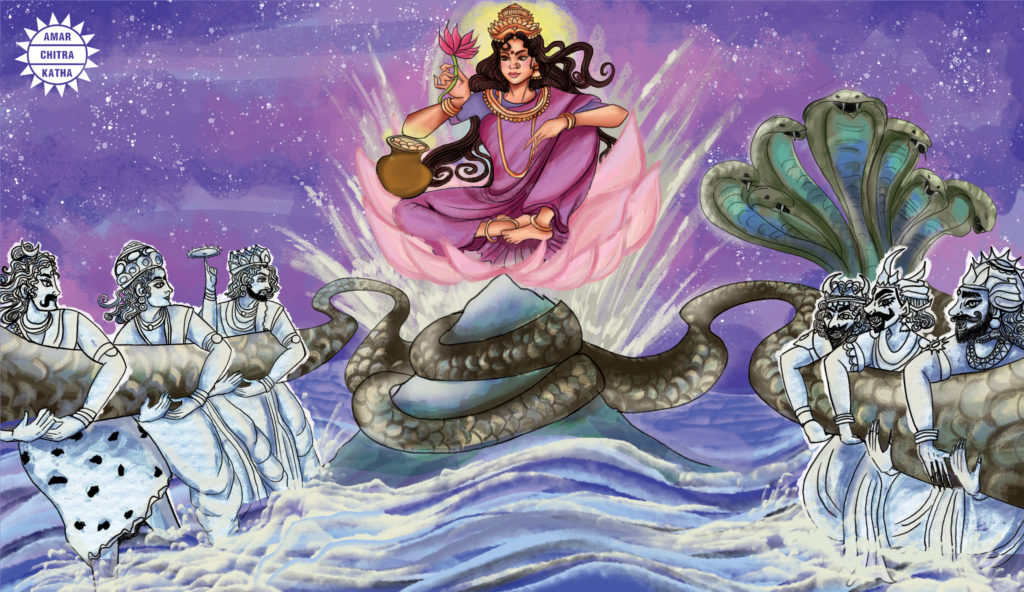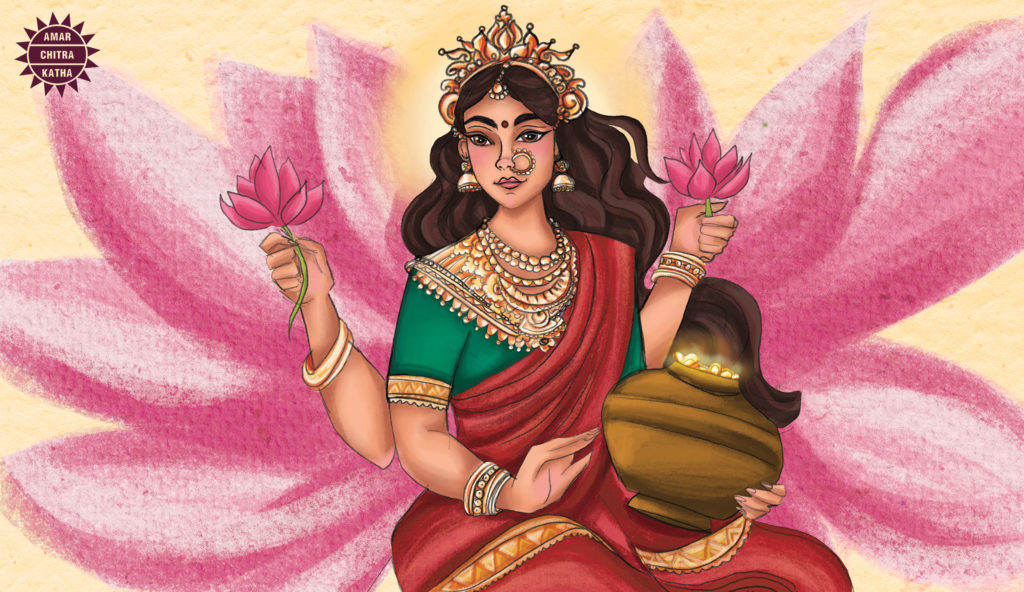Lakshmi, the Prosperous One
- January 25, 2024


Lakshmi, the Prosperous One
- January 25, 2024
By Kayva Gokhale
Open any journal or notebook in a Hindu household and you will probably observe the word ‘श्री’ or ‘Shri’ written at the top of the first page, before anything else gets noted down. The chances of this word appearing are even higher if the notebook in question is being used for book-keeping, accounts or similar work. Shri (Shriman or Shrimati) is also used as a prefix before someone’s name, like mister in English. For thousands of years, the word ‘Shri’ has been uttered or written down to invoke prosperity, auspiciousness and good fortune. Along with ‘Aum’, this word is perhaps one of the most commonly occurring and sacred words in Hindu tradition.
So, what does this word represent?
To receive more such stories in your Inbox & WhatsApp, Please share your Email and Mobile number.
Shri is one of the many names of Lakshmi, the Hindu Goddess of wealth, good fortune and prosperity. The wife of Vishnu, Lakshmi is the personification of all material wealth and comfort that humans desire. As the goddess of youth and beauty, she is often represented seated on a lotus, dressed in red, the colour of fertility, with her palms showering gold on her devotees. Lakshmi is one of the three manifestations of the Mother-Goddess, along with Durga and Saraswati. Unlike the other two however, her domain is over tangible and material wealth and success.
Most cultures have a goddess that represents the aspects of fertility, beauty, abundance and wealth. Greeks and Romans worshipped Demeter, Egyptians had Isis, Babylonians had Ishtar and in India, we have Shri. She represents all resources which provide us with comfort and the means to live. She is the bestower of prosperity and fortune in the material realm.
Like most myths, the one regarding the birth of Lakshmi has many variations. Different texts mention different circumstances describing how the goddess came into being.
The Vedas state that Lakshmi was born from the mouth of Prajapati, to provide food, clothing, shelter and material comfort to all beings. According to the Vishnu Purana, Lakshmi is the daughter of Sage Bhrigu and his wife, Khyati.

However, the most widely known and accepted story is that of Lakshmi being born out of the Samudra Manthan or churning of the cosmic ocean. Different versions of this myth appear in the Ramayana and few other Puranas. According to the most popular telling, Indra once invoked the wrath of Sage Durvasa and was cursed to lose his powers. Afraid of attacks by the asuras, the devas, led by Indra, approached Vishnu. He advised them to churn the cosmic ocean to obtain Amrit, the nectar of immortality, as well as other gifts that would restore their powers. However, the devas could not undertake this mammoth task alone. They then approached the asuras, promising them a share of the nectar, if they were to help with the churning. Following this agreement, the devas and asuras started churning the ocean, which resulted in various gifts, such as Surabhi the divine cow, Varuni the goddess of Wine, the magical Parijata Tree, Dhanvantari the god of Medicine, the Apsaras, etc., appearing from the ocean. The most important one, however, was Lakshmi herself. Decked in celestial finery and possessing divine beauty, Lakshmi appeared out of the ocean, seated on a lotus. Seeing her, many devas wished her for themselves, but only Vishnu himself was a worthy groom. They were married immediately, and she has lived as his loyal consort ever since.
The union of Vishnu and Lakshmi, unlike that of Shiva-Parvati, is less spoken about and discussed. However, more often than not, they are represented as two halves of a whole. If Vishnu is the preserver and protector, then Lakshmi represents the subject of his protection. This is seen most clearly in the myth of Vishnu’s Varaha avatar. According to the story, Vishnu takes the form of a boar to rescue Bhoomi Devi or Goddess Earth from the clutches of an asura. And who is Bhoomi Devi or Prithvi if not a manifestation of Lakshmi herself?
Lakshmi accompanies Vishnu in most of his avatars. When he is Vamana, she appears as a lotus. When he is Parashurama, she is his wife, Dharani. When he is Rama, she is Sita and when he is Krishna, she is Rukmini. Thus, without Lakshmi, Vishnu’s purpose is incomplete. Without her, there is no earth, no prosperity, no cycle of life which he can preserve and maintain.
The love between Vishnu and Lakshmi is legendary. According to one myth, Lakshmi, once upset with Vishnu, left him and descended to the earth as a mortal called Padmavati. Unable to live without her, Vishnu took the form of Shrinivasa, a mortal and was reunited and married to her on earth as well. The name Shrinivasa itself literally translates to ‘the dwelling of Shri’, referring to the belief that Lakshmi resides in Vishnu’s chest. One of Lakshmi’s names is also Haripriya or ‘the darling of Hari’.

While Lakshmi is worshipped as the consort of Vishnu, she is also seen as an independent deity. In this form, she is called Mahalakshmi. Communities that worship Mahalakshmi believe that she is the root of all creation. She represents Prakriti (nature) as well as Maya (illusion). According to one myth, she burst forth from Vishnu, as he was contemplating the creation of the universe. She then placed the seed of desire in his hand, unleashing the forces of creation which led to the universe being formed. Her association with desire and creation is further solidified in the Harivamsa, which names her the mother of Kama, the God of Love and Desire.
Lakshmi or Shri is ever-present. She is necessary for the sustenance of life itself. However, she is also characterised as ‘Chanchala’ or ‘the fickle one’, symbolising the transient nature of material wealth and difficulty in preserving it. Homes and business establishments are rarely seen without an image of Lakshmi, bestowing her generosity and driving away bad luck and loss. Perhaps the reason she is so ubiquitous and adored is because she is the one who turns dreams into reality and allows humans to work towards self-actualisation.
Read more such fascinating tales of gods and goddesses only on the ACK Comics app!
To receive more such stories in your Inbox & WhatsApp, Please share your Email and Mobile number.

Comic of The Month
Dr Kotnis in China
In 1938, twenty-eight-year-old Dr Dwarkanath Kotnis was part of a medical mission that India sent to aid China in its war with Japan. Dr Kotnis was committed to saving lives, even in the precarious war-time situation. He remained behind to continue his work in China after the rest of his group returned. He was, and remains, a selfless and fearless hero to the people of China and India alike.